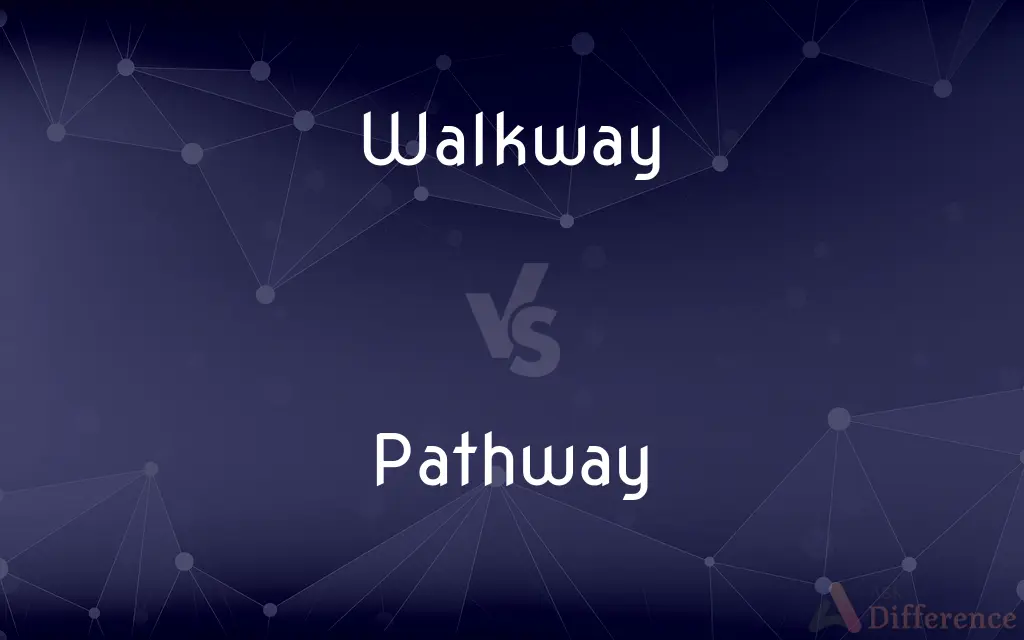Walkway vs. Pathway — What's the Difference?
By Fiza Rafique & Urooj Arif — Updated on March 25, 2024
A walkway is a designated path for walking, often paved and constructed, while a pathway is a general route or track, which can be natural or man-made.

Difference Between Walkway and Pathway
Table of Contents
ADVERTISEMENT
Key Differences
Walkways are typically constructed with specific materials like concrete, bricks, or stones, designed for pedestrian use in both urban and landscaped settings. Pathways, on the other hand, refer to any route that can be used for walking, which may be paved, dirt, or grass, and found in a variety of environments from gardens to wilderness areas.
While walkways are often associated with functional and aesthetic considerations in design, aiming to facilitate pedestrian movement in public spaces or around buildings, pathways might simply emerge from regular use over time or be deliberately created with a focus on blending into the natural environment.
The term "walkway" implies a certain level of formal construction and is often used in contexts where pedestrian traffic is heavy or where there's a need to connect specific points directly. "Pathway," however, evokes a broader and sometimes more scenic or natural usage, not limited to heavy foot traffic or urban environments.
Safety and accessibility standards, such as railings and non-slip surfaces, are more commonly associated with walkways, especially in commercial or public spaces, to accommodate a wide range of users, including those with disabilities. Pathways might not always meet these standards, offering a more natural or rugged experience, depending on their location and intended use.
While both walkways and pathways serve the purpose of facilitating pedestrian movement, walkways are more likely to be formally designed and constructed features, whereas pathways can range from simple dirt tracks to more structured routes, often integrating more closely with the natural landscape.
ADVERTISEMENT
Comparison Chart
Construction
Often paved with concrete, bricks, or stones.
Can be paved, dirt, grass, or other natural materials.
Setting
Urban areas, parks, gardens, around buildings.
Gardens, parks, natural settings, wilderness areas.
Design Purpose
To facilitate pedestrian movement with functional and aesthetic considerations.
To provide a route or track, which may be more integrated with the natural environment.
Usage
High foot traffic areas, connecting specific points.
Varied environments, not necessarily high foot traffic.
Safety Features
Commonly includes railings, non-slip surfaces, accessibility for disabilities.
May not always include safety features, offering a more natural experience.
Compare with Definitions
Walkway
Designed to connect points efficiently in urban or landscaped areas.
The walkway provided a direct route between the parking lot and the entrance.
Pathway
Might emerge naturally from use or be minimally designed.
A dirt pathway led to the hidden lake.
Walkway
Adheres to standards for accessibility and safety.
The new walkway was designed with ramps for wheelchair access.
Pathway
A route or track that can be natural or man-made, used for walking.
The forest pathway meandered through the dense woods.
Walkway
A paved route designed specifically for pedestrian use.
The landscaped walkway led visitors through the botanical garden.
Pathway
Offers a more scenic or natural experience, blending with the environment.
The stone pathway through the garden was lined with wildflowers.
Walkway
May include lighting, benches, and other amenities for comfort and safety.
The illuminated walkway ensured safe passage at night.
Pathway
Not necessarily designed with urban accessibility standards in mind.
The narrow pathway was bordered by steep slopes on either side.
Walkway
Often constructed with attention to aesthetics and durability.
The brick walkway added charm to the historic district.
Pathway
Can vary widely in terms of surface and maintenance.
The mountain pathway was rugged and challenging for hikers.
Walkway
A passage or path for walking along, especially a raised passageway connecting different sections of a building or a wide path in a park or garden.
Pathway
A path.
Walkway
In American English, walkway is a composite or umbrella term for all engineered surfaces or structures which support the use of trails. The New Oxford American Dictionary also defines a walkway as "a passage or path for walking along, esp.
Pathway
A course usually followed by a body part or process.
Walkway
A passage or path for walking, especially one that is roofed, paved, or elevated above its surroundings.
Pathway
A chain of nerve fibers along which impulses normally travel.
Walkway
A clearly defined path for pedestrians.
Pathway
A sequence of enzymatic or other reactions by which one biological material is converted to another.
Walkway
A path set aside for walking;
After the blizzard he shoveled the front walk
Pathway
A footpath or other path or track.
Pathway
(biochemistry) A sequence of biochemical compounds, and the reactions linking them, that describe a process in metabolism or catabolism.
Pathway
(figurative) A course of action.
Pathway
A footpath; a beaten track; any path or course. Also used figuratively.
In the way of righteousness is life; and in the pathway thereof is no death.
We tread the pathway arm in arm.
Pathway
A bundle of mylenated nerve fibers following a path through the brain
Pathway
A trodden path
Common Curiosities
Is a pathway always in a natural setting?
Not always, but pathways are more commonly associated with natural or scenic settings, even though they can be found in urban environments as well.
What is the main difference between a walkway and a pathway?
A walkway is a designated, often paved path for walking, usually in urban or landscaped areas, while a pathway is a more general term for a walking route that can be either natural or constructed.
Can a pathway be paved?
Yes, a pathway can be paved, but it can also be a natural dirt or grass track, offering a wider variety of surfaces than a typical walkway.
Can the terms walkway and pathway be used interchangeably?
While there is some overlap, the terms often imply different levels of construction, design, and setting, making them not completely interchangeable.
What makes a pathway scenic?
The natural surroundings, landscape design, and the way a pathway meanders through its environment contribute to its scenic quality, offering an immersive natural experience.
Do pathways require maintenance?
Yes, pathways do require maintenance, especially those in public parks or natural areas, to ensure they are navigable and safe, though the level of maintenance might be less intensive than for constructed walkways.
Can walkways have natural elements?
Yes, walkways can incorporate natural elements in their design, such as incorporating greenery or using natural stone, to enhance aesthetics and environmental integration.
How do walkways contribute to urban planning?
Walkways improve pedestrian accessibility, connect key points of interest, and enhance the safety and aesthetics of urban environments, playing a crucial role in urban design and planning.
Are walkways more expensive to construct than pathways?
Generally, yes, due to the materials, planning, and construction involved in building a walkway, especially those designed to meet certain aesthetic or safety standards.
Are walkways safer than pathways?
Walkways are often designed with specific safety features and accessibility in mind, making them potentially safer for a wider range of users, including those with disabilities, whereas pathways might offer a more natural experience with varying degrees of accessibility.
Share Your Discovery

Previous Comparison
Lapse vs. Mistake
Next Comparison
Medic vs. DoctorAuthor Spotlight
Written by
Fiza RafiqueFiza Rafique is a skilled content writer at AskDifference.com, where she meticulously refines and enhances written pieces. Drawing from her vast editorial expertise, Fiza ensures clarity, accuracy, and precision in every article. Passionate about language, she continually seeks to elevate the quality of content for readers worldwide.
Co-written by
Urooj ArifUrooj is a skilled content writer at Ask Difference, known for her exceptional ability to simplify complex topics into engaging and informative content. With a passion for research and a flair for clear, concise writing, she consistently delivers articles that resonate with our diverse audience.














































